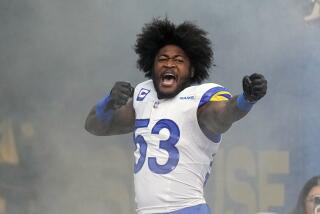Upheaval Price of Success for St. Louis Rams
ST. LOUIS — The celebration was brief for the Super Bowl champions.
It’s been less than a month since the St. Louis Rams capped their stunning turnaround with a 23-16 victory over the Tennessee Titans. But since the victory parade, there’s been a parade of departing coaches and players.
Out are Dick Vermeil and most of his 60-something staff.
In are new head coach Mike Martz and a younger braintrust.
Gone are two starting offensive linemen and an important pass-rushing linebacker, all victims of the annual Super Bowl raiding parties and a tight salary cap.
So much for continuity.
But it’s primarily business as usual.
“Really, there’s fewer changes this year than last year,” Martz said. “It’s just normal. You look at Green Bay and Denver, it’s all relative.”
Vermeil used to note that teams usually turn over about 19-20 players from each year, particularly since free agency arrived in 1993.
Martz agrees.
“That’s the NFL,” Martz said. “Nothing’s any different from the past.”
Still, the Rams already have lost three players who had key roles in the Super Bowl run.
Right tackle Fred Miller signed with the Titans, replacing Tennessee’s own free-agent defector, Jon Runyan. The Arizona Cardinals outbid them for center Mike Gruttadauria an offer he couldn’t refuse and linebacker Charlie Clemons, a pass-rushing specialist, signed a four-year, $6 million deal with the Saints.
Another backup, defensive end Jay Williams, got $4.3 million over three years from the Panthers.
But the Rams think they have the depth to replacing them and foresee no glaring needs entering next season.
“We don’t have to go out and sign a free agent to start for us someplace,” general manager Charley Armey said. “We don’t have that problem, and that’s a major problem. You’re counting on a guy and you pay top dollar for him and you think he’s going to be good, but you don’t know.”
The Rams filled the offensive line vacancies from within.
They matched the Miami Dolphins’ four-year, $8.25 million offer sheet for backup offensive lineman Ryan Tucker. Another backup, Andy McCollum, got a three-year, $3.4 million deal to be the starting center. They’ll likely plug in Leonard Little, a third-round pick in 1998, at Clemons’ old spot.
“You can’t keep everybody,” Armey said. “The salary cap won’t allow that. But I couldn’t be happier, coming off a Super Bowl championship being able to solve most of the problems from within our organization.”
Armey, promoted from personnel director the same week Vermeil resigned, said he anticipated almost everything that’s happened. He’s already anticipating next year’s potential problems.
The only surprise was the Dolphins’ pricey offer for the seldom-used Tucker, whose career has been hindered by a college knee injury and a neck injury. The Rams believe he’ll eventually be better than Miller because of his athletic ability, but they didn’t know anyone else had a similar assessment.
The Rams’ basic strategy heading into the offseason was to lock up their core players. That is mostly done.
Now that Tucker and McCollum are signed, the entire offensive line, including Pro Bowlers Orlando Pace and Adam Timmerman, is under contract for three years. The team made cornerback Todd Lyght a transition player while continuing to negotiate a long-term contract.
The NFL’s offensive player of the year, Marshall Faulk, has six years to go on a $45 million deal. The team plans to negotiate long-term contracts with wide receiver Isaac Bruce and defensive end Kevin Carter, both entering the final years of their deals.
One financial problem could be quarterback.
Trent Green, whose knee injury gave Kurt Warner his chance, is entering the second year of a four-year, $16.5 million deal as an expensive backup behind league MVP Kurt Warner. The Rams are obligated to pay Warner only about $350,000 because he’s a restricted rights free agent, but they’ll likely pay him $1 million or more this year.
Not that it’s a worry.
Martz, the Redskins’ quarterbacks coach when Green enjoyed his breakout season in 1998, would like to keep both next year. Hindering a Green trade is a salary cap hit of about $3 million that the Rams would have to absorb.
Armey said there’s plenty of time to sort that out.
Martz said on the day he was hired that he wanted to keep the staff intact.
But that didn’t happen.
John Bunting, who had been co-defensive coordinator, was fired after Martz decided to give the coordinator job to Peter Guinta. Vermeil aides Mike White, who had been assistant head coach, and Lynn Styles, who had been a team vice president as well as tight ends coach, were no longer needed.
Frank Gansz resigned, ostensibly because he wanted to spend more time with his family. But on Thursday he was hired by the Jaguars.
Martz also moved Wilbert Montgomery from running backs coach to tight ends, hired former Redskins running backs coach Bobby Jackson to fill Montgomery’s old spot and plugged in Larry Pasquale for special teams.
“I’ll be blunt with you, usually it’s the head coaches’ prerogative when he comes in to let them all go and bring in whoever he wants,” Martz said. “But that’s not what we did.
“There were a couple of changes and those things just happen. But nothing out of the ordinary. Things are going very well.”
More to Read
Go beyond the scoreboard
Get the latest on L.A.'s teams in the daily Sports Report newsletter.
You may occasionally receive promotional content from the Los Angeles Times.










